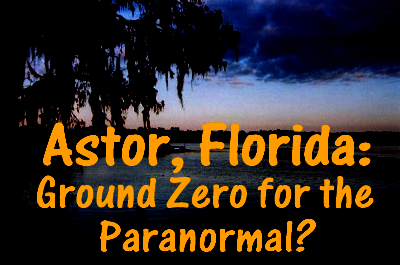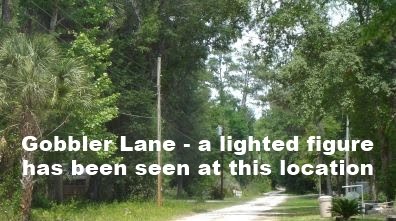

| Visitors Now: | |
| Total Visits: | |
| Total Stories: |

| Story Views | |
| Now: | |
| Last Hour: | |
| Last 24 Hours: | |
| Total: | |
Astor, Florida: Ground Zero For The Paranormal?
By David Hoes - Astor is a town of about 1500 residents that has a rich, but sometimes violent history. It is also the focal point for a remarkable variety of paranormal phenomena. The following is a listof some of the strange events in and around Astor:
- The ghost of an Indian chief and a French Huguenot Monk have been seen in the area
- A dinosaur-like river monster known as "Pinky" has been sighted by numerous witnesses
- UFOs have frequently been spotted in local skies
- Skunk Apes, a Florida version of Bigfoot, are said to inhabit the surrounding forest
- The town's lighthouse-keeper and drawbridge-tender were mysteriously murdered
- The leading citizen and largest property owner died on the Titanic
- A Transylvanian Count served as newspaper publisher and local historian
Astor History
Astor is located almost due north of Orlando and due west of Daytona Beach, on the west bank of the St. John's River. The lands around Astor were originally inhabited by Timucua Indians. There is a large shell mound just north of town where in the 1880s archeologists uncovered a number of relics and human remains.
French Huguenots escaping religious persecution settled at the present site of Astor in 1562. However, the entire colony was wiped out by Spanish troops in 1566. Later, the Spanish were driven out by the British.
The next European to settle in the area was James Spalding, who established a trading post at the present site of Astor in 1763. By that time, there were only about two dozen Timucua still alive. The rest had been killed by disease or war.
In 1822, a Jewish immigrant, Moses Elias Levy, raised oranges and sugar cane at the future site of Astor. During the Seminole wars, several forts were built in the vicinity. While some battles took place, more US troops died from disease than from combat. By 1870, the area was largely deserted.
However, in 1874, William B. Astor, Sr., purchased 12,000 acres of land along the St. John's river and established the town ofManhattan. When Astor died twenty years later, the town was officially renamed Astor in his honor. His son, John Jacob Astor IVinherited his father's estate and continued to promote the town. John Jacob Astor IV is remembered for his heroism during the sinking of the Titanic in 1912, when he gave-up up his place in a lifeboat to another passenger.
A more recent but somewhat less famous resident of Astor wasCount Albert Wass de Szentegyed et Czege, (known as A. Wass de Czege) a Transylvanian nobleman and author, who came to Astor following World War II. He was the publisher of the local newspaper and a local historian.
Historical Legends
In his book, The history of Astor on the St. Johns, Astor Park, and the surrounding area, Count A. Wass de Czege tells of several local legends.
The first is the story of Oklawahumpka, the Indian chief who could not die. Spanish troops killed all of the members of an neighboring Indian tribe except for the chief, a large, powerful man.
Oklawahumpka took the tribe's totem pole to an island in the center of a desolate, forbidden swamp. A hawk, the symbol of the tribe, was carved in the top of this pole.
Years later, a group of Spanish soldiers led by Don Huerta explored this territory. He left some of his men with the boats while he and the rest of his troops explored the island. Neither Don Huerta nor the men with him were ever seen again. The soldiers who stayed with the boats reported hearing the cry of a large bird, possibly an eagle or hawk.
Over the years, others also vanished. Pirates who tried to escape justice by hiding in the swamp disappeared without a trace. Jonathan Higgins, manager of the Spalding trading post, also vanished here. His wife reported hearing the cry of a hawk coming from the swamp. In 1838 and 1863, US troops also disappeared here.
The last documented disappearance was in 1904 when a young surveyor failed to return. Searchers found a large footprint with one toe missing close to where the surveyor was last seen. According to legend, Oklawahumpka lost a toe to an alligator when he was a child.
The forbidden swamp still exists, somewhere northeast of Alexander Springs. From time to time, fishermen report seeing large footprints in the mud on the banks of Alexander Creek.
Another ghost story involves a French Huguenot monk. After the Spanish massacred the French settlers in 1566, they tied the only survivor, a monk, to a tree and tortured him until he died.
The ghost of the unfortunate monk has been seen over the centuries; some say his ghost still haunts Astor. In several on-line directories of haunted places, there are references made to a glowing figure who appears on a densely wooded street called Gobbler Road. Is this the ghost of the monk who died so many years ago?
The Astor Monster
Reports of the Astor Monster, also called "Pinky" and “The St. John's Monster” have circulated for hundreds of years. William Bartram, a famous American naturalist, traveled through Astor and Lake George in 1774. He wrote that his Indian guide kept referring to "the beast of the deep." Bartram later reported seeing "fiery dragons" around Volusia Bar in Lake George. This is where the lighthouse was later built.
The St. Francis Gazette of August 24, 1896, reported that "something dangerously large" overturned a fishing boat in a nearby lake. A week later, there was a report that the steamer "Osceola" was struck by something large near the same location.
Quite a few reports surfaced between 1949 and 1956. In 1949, a Jacksonville paper published a sketch of the "Astor Monster" as seen by a river guide. In 1956, strange footprints were found in the mud along the river. They were described as being about 10 inches long and reptilian, with three toes pointed to the front and two to the rear. Descriptions of the creature varied greatly, with some claiming it looked like a dinosaur and others describing a creature more like a manatee. According to one report, the creature had a single horn in the center of its head.
During the 1950s, over a dozen witnesses claimed to have seen the Astor Monster. Several individuals claimed to have shot at it but missed.
In his book Florida's Unexpected Wildlife: Exotic Species, Living Fossils, and Mythical Beasts in the Sunshine State, Michael Newton reported that in the late 1960s, fishing guide Buck Dillardand two clients encountered a beast 'the size of an elephant' while trolling on the St. Johns River near Lake Dexter. "Dillard says the creature walked along the river bottom, thus presumably eliminating possible confusion with a manatee."
The last reported sighting of the monster was in August of 1987, when two young men claimed to have struck it with their boat. Reportedly, it was about 35 feet long, greenish-gray, and had spikes on its back.
Cryptozoologist Loren Coleman mounted a 2008 expedition to search for Pinky, but was unsuccessful in learning more about the creature.
One newspaper reporter suggested that Pinky was a hoax. In a 1995 article in the Orlando Sentinel, Ormund Powers recalled a conversation he had with Count A. Wass deCzege, the former publisher of the newspaper in Astor.
“When I asked the Count to help me trace the origin of the Astor Monster, he let that question go by and instead told me a story about the Loch Ness Monster of Scotland.
'I knew the two men who invented the Loch Ness Monster,' he said.
'That thing was invented?' I asked.
'Out of whole cloth. They got together one day in Europe and decided they would invent a monster,' the count said. 'That was many, many years ago, you know. They just made him up from their overactive imaginations.'”




